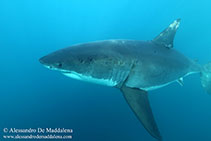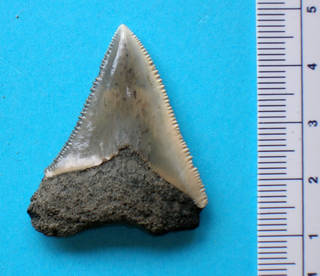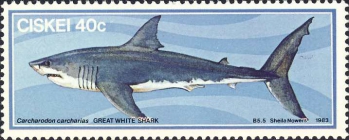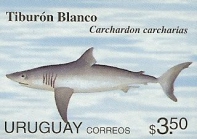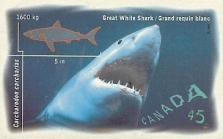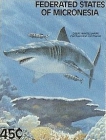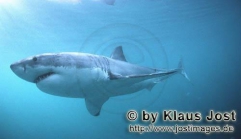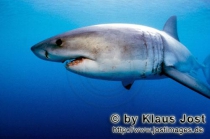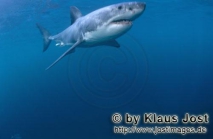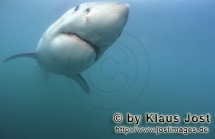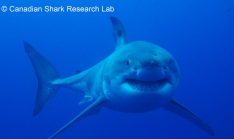WoRMS taxon details
Carcharodon carcharias (Linnaeus, 1758)
105838 (urn:lsid:marinespecies.org:taxname:105838)
accepted
Species
Carcharias atwoodi Storer, 1848 · unaccepted
Carcharias lamia Rafinesque, 1810 · unaccepted
Carcharias maso Morris, 1898 · unaccepted
Carcharias rondeletti Bory de Saint-Vincent, 1829 · unaccepted
Carcharias verus Cloquet, 1817 · unaccepted
Carcharias vorax Owen, 1853 · unaccepted
Carcharias vulgaris (Richardson, 1836) · unaccepted
Carcharodon albimors Whitley, 1939 · unaccepted
Carcharodon capensis Smith, 1839 · unaccepted
Carcharodon rondeletii Müller & Henle, 1839 · unaccepted
Carcharodon smithi Bonaparte, 1838 · unaccepted
Carcharodon smithii Agassiz, 1838 · unaccepted
Carharodon carcharias (Linnaeus, 1758) · unaccepted > misspelling - incorrect subsequent spelling
Squalus caninus Osbeck, 1765 · unaccepted (synonym)
Squalus carcharias Linnaeus, 1758 · unaccepted
Squalus lamia Blainville, 1825 · unaccepted
Squalus lamia Blainville, 1816 · unaccepted
Squalus vulgaris Richardson, 1836 · unaccepted
marine, brackish, fresh, terrestrial
(of Squalus carcharias Linnaeus, 1758) Linnaeus, C. (1758). Systema Naturae per regna tria naturae, secundum classes, ordines, genera, species, cum characteribus, differentiis, synonymis, locis. [The system of nature through the three kingdoms of nature, according to classes, orders, genera, species, with characters, differences, synonyms, places.]. <em>Impensis Direct. Laurentii Salvii. Holmiae [Stockholm].</em> 1(10) [iii], 824 p., available online at https://biodiversitylibrary.org/page/726886 [details] Available for editors  [request]
[request]
Type locality contained in Europe
type locality contained in Europe [details]
Description Possibly to 8 m, world's largest predator. Generally in the open ocean, but does swim into shallower waters. Most attacks...
Distribution Newfoundland to Argentina
Description Possibly to 8 m, world's largest predator. Generally in the open ocean, but does swim into shallower waters. Most attacks occurred in estuaries. Usually swims alone or in pairs but can be found in feeding aggregations. A versatile predator with a broad prey spectrum. Feeds on sturgeon and tunas, as well as sea lions and other large animals and fish (Ref. 9987). Presumably ovoviviparous. Reported by some experts to attack humans which they mistake for their normal prey of seals. Reported to cause poisoning (Ref. 4690). Meat is utilized fresh and smoked for human consumption, the skin for leather and the liver for oil (Ref. 9987). [details]
Distribution Newfoundland to Argentina
Distribution Newfoundland to Argentina [details]
Froese, R. and D. Pauly. Editors. (2025). FishBase. Carcharodon carcharias (Linnaeus, 1758). Accessed through: World Register of Marine Species at: https://www.marinespecies.org/aphia.php?p=taxdetails&id=105838 on 2025-07-06
Date
action
by
![]() The webpage text is licensed under a Creative Commons
Attribution-Noncommercial 4.0 License
The webpage text is licensed under a Creative Commons
Attribution-Noncommercial 4.0 License
Nomenclature
original description
(of Squalus carcharias Linnaeus, 1758) Linnaeus, C. (1758). Systema Naturae per regna tria naturae, secundum classes, ordines, genera, species, cum characteribus, differentiis, synonymis, locis. [The system of nature through the three kingdoms of nature, according to classes, orders, genera, species, with characters, differences, synonyms, places.]. <em>Impensis Direct. Laurentii Salvii. Holmiae [Stockholm].</em> 1(10) [iii], 824 p., available online at https://biodiversitylibrary.org/page/726886 [details] Available for editors  [request]
[request]
basis of record van der Land, J.; Costello, M.J.; Zavodnik, D.; Santos, R.S.; Porteiro, F.M.; Bailly, N.; Eschmeyer, W.N.; Froese, R. (2001). Pisces, <B><I>in</I></B>: Costello, M.J. <i>et al.</i> (Ed.) (2001). <i>European register of marine species: a check-list of the marine species in Europe and a bibliography of guides to their identification. Collection Patrimoines Naturels,</i> 50: pp. 357-374 (look up in IMIS) [details]
basis of record van der Land, J.; Costello, M.J.; Zavodnik, D.; Santos, R.S.; Porteiro, F.M.; Bailly, N.; Eschmeyer, W.N.; Froese, R. (2001). Pisces, <B><I>in</I></B>: Costello, M.J. <i>et al.</i> (Ed.) (2001). <i>European register of marine species: a check-list of the marine species in Europe and a bibliography of guides to their identification. Collection Patrimoines Naturels,</i> 50: pp. 357-374 (look up in IMIS) [details]
Ecology
ecology source
Looby, A.; Erbe, C.; Bravo, S.; Cox, K.; Davies, H. L.; Di Iorio, L.; Jézéquel, Y.; Juanes, F.; Martin, C. W.; Mooney, T. A.; Radford, C.; Reynolds, L. K.; Rice, A. N.; Riera, A.; Rountree, R.; Spriel, B.; Stanley, J.; Vela, S.; Parsons, M. J. G. (2023). Global inventory of species categorized by known underwater sonifery. <em>Scientific Data.</em> 10(1). (look up in IMIS), available online at https://doi.org/10.1038/s41597-023-02745-4 [details] 
Other
context source (Deepsea)
Intergovernmental Oceanographic Commission (IOC) of UNESCO. The Ocean Biogeographic Information System (OBIS), available online at http://www.iobis.org/ [details]
context source (HKRMS) Lam VYY. (2009). The shark fisheries of Southern China and the reproductive biology of the spadenose shark, Scoliodon laticaudus. Mphil thesis. The University of Hong Kong. [details]
context source (RAS) Australian Antarctic Data Centre. , available online at https://data.aad.gov.au/aadc/biodiversity/ [details]
context source (Bermuda) Smith-Vaniz, W. F.; Collette, B. B.; Luckhurst, B. E (1999). Fishes of Bermuda: History, zoogeography, annotated checklist, and identification keys (American Society of Ichthyologists and Herpetologists - Special Publication No.4) . ASIH, 424 pp. [details]
context source (PeRMS) Chirichigno, N.; Cornejo, M. (2001). Catálogo comentado de los peces marinos del Perú. <em>2ª ed. Instituto del Mar de Perú. Publicación Especial. Callao.</em> 314 p. [details]
additional source Scott, W.B.; Scott, M.G. (1988). Atlantic fishes of Canada. <em>Canadian Bulletin of Fisheries and Aquatic Sciences.</em> No. 219. 731 pp. [details]
additional source King, C.M.; Roberts, C.D.; Bell, B.D.; Fordyce, R.E.; Nicoll, R.S.; Worthy, T.H.; Paulin, C.D.; Hitchmough, R.A.; Keyes, I.W.; Baker, A.N.; Stewart, A.L.; Hiller, N.; McDowall, R.M.; Holdaway, R.N.; McPhee, R.P.; Schwarzhans, W.W.; Tennyson, A.J.D.; Rust, S.; Macadie, I. (2009). Phylum Chordata: lancelets, fishes, amphibians, reptiles, birds, mammals. <em>in: Gordon, D.P. (Ed.) (2009). New Zealand inventory of biodiversity: 1. Kingdom Animalia: Radiata, Lophotrochozoa, Deuterostomia.</em> pp. 431-554. [details]
additional source Compagno, L.J.V. (2001). Sharks of the world. An annotated and illustrated catalogue of shark species known to date. Volume 2. Bullhead, mackerel and carpet sharks (Heterodontiformes, Lamniformes and Orectolobiformes). <em>FAO Species Catalogue for Fishery Purposes.</em> No. 1, Vol. 2. Rome, FAO. 269p. [details]
additional source McEachran, J. D. (2009). Fishes (Vertebrata: Pisces) of the Gulf of Mexico, Pp. 1223–1316 in: Felder, D.L. and D.K. Camp (eds.), Gulf of Mexico–Origins, Waters, and Biota. Biodiversity. Texas A&M Press, College Station, Texas. [details]
additional source Liu, J.Y. [Ruiyu] (ed.). (2008). Checklist of marine biota of China seas. <em>China Science Press.</em> 1267 pp. (look up in IMIS) [details] Available for editors [request]
[request]
additional source Froese, R. & D. Pauly (Editors). (2025). FishBase. World Wide Web electronic publication. version (06/2024)., available online at https://www.fishbase.org [details]
context source (HKRMS) Lam VYY. (2009). The shark fisheries of Southern China and the reproductive biology of the spadenose shark, Scoliodon laticaudus. Mphil thesis. The University of Hong Kong. [details]
context source (RAS) Australian Antarctic Data Centre. , available online at https://data.aad.gov.au/aadc/biodiversity/ [details]
context source (Bermuda) Smith-Vaniz, W. F.; Collette, B. B.; Luckhurst, B. E (1999). Fishes of Bermuda: History, zoogeography, annotated checklist, and identification keys (American Society of Ichthyologists and Herpetologists - Special Publication No.4) . ASIH, 424 pp. [details]
context source (PeRMS) Chirichigno, N.; Cornejo, M. (2001). Catálogo comentado de los peces marinos del Perú. <em>2ª ed. Instituto del Mar de Perú. Publicación Especial. Callao.</em> 314 p. [details]
additional source Scott, W.B.; Scott, M.G. (1988). Atlantic fishes of Canada. <em>Canadian Bulletin of Fisheries and Aquatic Sciences.</em> No. 219. 731 pp. [details]
additional source King, C.M.; Roberts, C.D.; Bell, B.D.; Fordyce, R.E.; Nicoll, R.S.; Worthy, T.H.; Paulin, C.D.; Hitchmough, R.A.; Keyes, I.W.; Baker, A.N.; Stewart, A.L.; Hiller, N.; McDowall, R.M.; Holdaway, R.N.; McPhee, R.P.; Schwarzhans, W.W.; Tennyson, A.J.D.; Rust, S.; Macadie, I. (2009). Phylum Chordata: lancelets, fishes, amphibians, reptiles, birds, mammals. <em>in: Gordon, D.P. (Ed.) (2009). New Zealand inventory of biodiversity: 1. Kingdom Animalia: Radiata, Lophotrochozoa, Deuterostomia.</em> pp. 431-554. [details]
additional source Compagno, L.J.V. (2001). Sharks of the world. An annotated and illustrated catalogue of shark species known to date. Volume 2. Bullhead, mackerel and carpet sharks (Heterodontiformes, Lamniformes and Orectolobiformes). <em>FAO Species Catalogue for Fishery Purposes.</em> No. 1, Vol. 2. Rome, FAO. 269p. [details]
additional source McEachran, J. D. (2009). Fishes (Vertebrata: Pisces) of the Gulf of Mexico, Pp. 1223–1316 in: Felder, D.L. and D.K. Camp (eds.), Gulf of Mexico–Origins, Waters, and Biota. Biodiversity. Texas A&M Press, College Station, Texas. [details]
additional source Liu, J.Y. [Ruiyu] (ed.). (2008). Checklist of marine biota of China seas. <em>China Science Press.</em> 1267 pp. (look up in IMIS) [details] Available for editors
additional source Froese, R. & D. Pauly (Editors). (2025). FishBase. World Wide Web electronic publication. version (06/2024)., available online at https://www.fishbase.org [details]
 Present
Present  Present in aphia/obis/gbif/idigbio
Present in aphia/obis/gbif/idigbio  Inaccurate
Inaccurate  Introduced: alien
Introduced: alien  Containing type locality
Containing type locality
Unreviewed
Description Possibly to 8 m, world's largest predator. Generally in the open ocean, but does swim into shallower waters. Most attacks occurred in estuaries. Usually swims alone or in pairs but can be found in feeding aggregations. A versatile predator with a broad prey spectrum. Feeds on sturgeon and tunas, as well as sea lions and other large animals and fish (Ref. 9987). Presumably ovoviviparous. Reported by some experts to attack humans which they mistake for their normal prey of seals. Reported to cause poisoning (Ref. 4690). Meat is utilized fresh and smoked for human consumption, the skin for leather and the liver for oil (Ref. 9987). [details]Diet Bony fishes such as salmon, hake, halibut, mackerel and tunas. As well, other sharks, sea turtles, seabirds and marine mammals are eaten. [details]
Distribution Newfoundland to Argentina [details]
Habitat nektonic [details]
Habitat Found in coastal and offshore waters, may enter small bays and harbours and approach shore. [details]
Importance Social & Scientific- Fatal attacks on humans and small boats, flesh and fins used for human food, liver is rich in oil, skin is used for leather, carcass is used for fish meal. [details]
Predators Man and possibly other white sharks [details]
Reproduction Presumed to be ovoviviparous [details]
| Language | Name | |
|---|---|---|
| Afrikaans | withaaiwitdoodshaaispringhaaisarda | [details] |
| Albanian | peshkaqen njeringrënës | [details] |
| Dutch | witte haai | [details] |
| English | white sharkwhite pointerwhite death sharkwhite deathuptailtuna sharkTommymudsharkman-eater sharkjumping sharkgreat white sharkgreat white deathdemon sharkdeath sharkcowsharkblue pointeranchovy-eater | [details] |
| French | requin blancgrand requin blanc | [details] |
| German | Weisshaiweißer HaiMerviel FrasMenschenhai | [details] |
| Hawaiian | niuhi | [details] |
| Hebrew | קרחה לבנה | [details] |
| Italian | tunnu palamitu di funnusqualo biancopisci mastinupisci canipici bistinupesciu canpescecanepesce canepesce can grandepesca canmastinu ferumangia alicelamiaimbestinudamianocarcarodonte lamiacarcarodonte di rondeletcarcarodontecaniscucan grossucagniacagnesca grande | [details] |
| Japanese | ホホジロザメoshirozamehohojirozamehitokiuzame | [details] |
| Lithuanian | baltasis ryklys | [details] |
| Maltese | kelb-il-bahar abjadkelb il-baharhuta tax-xmaragab doll | [details] |
| Maori | taniwhamango-tuatinihare hongi | [details] |
| Modern Greek (1453-) | Λευκός καρχαρίαςkarcharias | [details] |
| Norwegian | hvithaihaa skieding | [details] |
| Polish | żarłacz biały | [details] |
| Portuguese | tubarâo brancotabarao | [details] |
| Russian | мегалодонкархародон мегалодон | [details] |
| Samoan | tanifa | [details] |
| Slovenian | veliki beli morski pes | [details] |
| Spanish | tiburón blancotiburotauró blanctaburosardasalroigsalproixsalproigmarracojaquetón de leyjaquetón blancoca mari | [details] |
| Turkish | büyük beyaz köpekbalığıbuyuk beyaz kopekbaligi | [details] |
| Ukrainian | Велика біла акулаБіла акулаАкула велика біла | [details] |
To Barcode of Life (171 barcodes)
To Biodiversity Heritage Library (130 publications) (from synonym Carcharias lamia Rafinesque, 1810)
To Biodiversity Heritage Library (169 publications) (from synonym Squalus carcharias Linnaeus, 1758)
To Biodiversity Heritage Library (184 publications)
To Biodiversity Heritage Library (23 publications) (from synonym Carcharias atwoodi Storer, 1848)
To Biodiversity Heritage Library (24 publications) (from synonym Carcharodon capensis Smith, 1839)
To Biodiversity Heritage Library (3 publications) (from synonym Carcharias maso Morris, 1898)
To Biodiversity Heritage Library (3 publications) (from synonym Carcharias vorax Owen, 1853)
To Biodiversity Heritage Library (31 publications) (from synonym Carcharias verus Cloquet, 1817)
To Biodiversity Heritage Library (4 publications) (from synonym Squalus lamia Blainville, 1816)
To Biodiversity Heritage Library (4 publications) (from synonym Squalus lamia Blainville, 1825)
To Biodiversity Heritage Library (4 publications) (from synonym Carcharodon smithi Bonaparte, 1838)
To Biodiversity Heritage Library (5 publications) (from synonym Carcharodon smithii Agassiz, 1838)
To Biodiversity Heritage Library (5 publications) (from synonym Carcharodon albimors Whitley, 1939)
To Biodiversity Heritage Library (7 publications) (from synonym Squalus vulgaris Richardson, 1836)
To Biodiversity Heritage Library (79 publications) (from synonym Carcharias vulgaris (Richardson, 1836))
To Biodiversity Heritage Library (8 publications) (from synonym Carcharias rondeletti Bory de Saint-Vincent, 1829)
To Biodiversity Heritage Library (87 publications) (from synonym Carcharodon rondeletii Müller & Henle, 1839)
To Biological Information System for Marine Life (BISMaL)
To European Nucleotide Archive, ENA (Carcharodon carcharias)
To FAO Species fact sheets
To FishBase
To FishBase (from synonym Carcharodon capensis Smith, 1839)
To FishBase (from synonym Carcharodon albimors Whitley, 1939)
To FishBase (from synonym Carcharodon smithi Bonaparte, 1838)
To FishBase (from synonym Carcharodon rondeletii Müller & Henle, 1839)
To FishBase (from synonym Carcharias atwoodi Storer, 1848)
To FishBase (from synonym Carcharodon smithii Agassiz, 1838)
To FishBase (from synonym Carcharias verus Cloquet, 1817)
To FishBase (from synonym Carcharias rondeletti Bory de Saint-Vincent, 1829)
To FishBase (from synonym Carcharias lamia Rafinesque, 1810)
To FishBase (from synonym Carcharias maso Morris, 1898)
To FishBase (from synonym Squalus carcharias Linnaeus, 1758)
To FishBase (from synonym Carcharias vorax Owen, 1853)
To FishBase (from synonym Carcharias vulgaris (Richardson, 1836))
To FishBase (from synonym Squalus caninus Osbeck, 1765)
To FishBase (from synonym Squalus lamia Blainville, 1816)
To FishBase (from synonym Squalus vulgaris Richardson, 1836)
To FishBase (from synonym Squalus lamia Blainville, 1825)
To FishBase images (Carcharodon carcharias, Australia, by De Maddalena, A.)
To Fishipedia
To GenBank (71288 nucleotides; 46302 proteins)
To GenBank (71288 nucleotides; 46302 proteins) (from synonym Squalus carcharias Linnaeus, 1758)
To Global Biotic Interactions (GloBI)
To IUCN Red List (Vulnerable)
To NMNH Paleobiology Collection (USNM PAL 336204 Carcharodon carcharius)
To PESI
To ITIS
To Biodiversity Heritage Library (130 publications) (from synonym Carcharias lamia Rafinesque, 1810)
To Biodiversity Heritage Library (169 publications) (from synonym Squalus carcharias Linnaeus, 1758)
To Biodiversity Heritage Library (184 publications)
To Biodiversity Heritage Library (23 publications) (from synonym Carcharias atwoodi Storer, 1848)
To Biodiversity Heritage Library (24 publications) (from synonym Carcharodon capensis Smith, 1839)
To Biodiversity Heritage Library (3 publications) (from synonym Carcharias maso Morris, 1898)
To Biodiversity Heritage Library (3 publications) (from synonym Carcharias vorax Owen, 1853)
To Biodiversity Heritage Library (31 publications) (from synonym Carcharias verus Cloquet, 1817)
To Biodiversity Heritage Library (4 publications) (from synonym Squalus lamia Blainville, 1816)
To Biodiversity Heritage Library (4 publications) (from synonym Squalus lamia Blainville, 1825)
To Biodiversity Heritage Library (4 publications) (from synonym Carcharodon smithi Bonaparte, 1838)
To Biodiversity Heritage Library (5 publications) (from synonym Carcharodon smithii Agassiz, 1838)
To Biodiversity Heritage Library (5 publications) (from synonym Carcharodon albimors Whitley, 1939)
To Biodiversity Heritage Library (7 publications) (from synonym Squalus vulgaris Richardson, 1836)
To Biodiversity Heritage Library (79 publications) (from synonym Carcharias vulgaris (Richardson, 1836))
To Biodiversity Heritage Library (8 publications) (from synonym Carcharias rondeletti Bory de Saint-Vincent, 1829)
To Biodiversity Heritage Library (87 publications) (from synonym Carcharodon rondeletii Müller & Henle, 1839)
To Biological Information System for Marine Life (BISMaL)
To European Nucleotide Archive, ENA (Carcharodon carcharias)
To FAO Species fact sheets
To FishBase
To FishBase (from synonym Carcharodon capensis Smith, 1839)
To FishBase (from synonym Carcharodon albimors Whitley, 1939)
To FishBase (from synonym Carcharodon smithi Bonaparte, 1838)
To FishBase (from synonym Carcharodon rondeletii Müller & Henle, 1839)
To FishBase (from synonym Carcharias atwoodi Storer, 1848)
To FishBase (from synonym Carcharodon smithii Agassiz, 1838)
To FishBase (from synonym Carcharias verus Cloquet, 1817)
To FishBase (from synonym Carcharias rondeletti Bory de Saint-Vincent, 1829)
To FishBase (from synonym Carcharias lamia Rafinesque, 1810)
To FishBase (from synonym Carcharias maso Morris, 1898)
To FishBase (from synonym Squalus carcharias Linnaeus, 1758)
To FishBase (from synonym Carcharias vorax Owen, 1853)
To FishBase (from synonym Carcharias vulgaris (Richardson, 1836))
To FishBase (from synonym Squalus caninus Osbeck, 1765)
To FishBase (from synonym Squalus lamia Blainville, 1816)
To FishBase (from synonym Squalus vulgaris Richardson, 1836)
To FishBase (from synonym Squalus lamia Blainville, 1825)
To FishBase images (Carcharodon carcharias, Australia, by De Maddalena, A.)
To Fishipedia
To GenBank (71288 nucleotides; 46302 proteins)
To GenBank (71288 nucleotides; 46302 proteins) (from synonym Squalus carcharias Linnaeus, 1758)
To Global Biotic Interactions (GloBI)
To IUCN Red List (Vulnerable)
To NMNH Paleobiology Collection (USNM PAL 336204 Carcharodon carcharius)
To PESI
To ITIS
